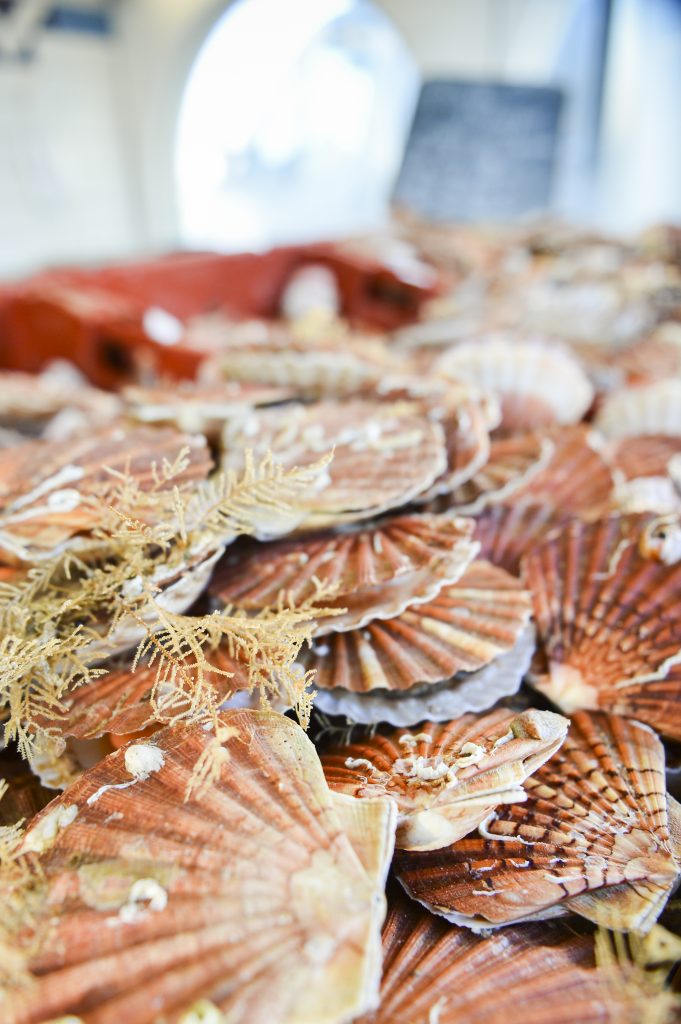How generous the waters along the Côte d’Opale are! The Channel and the North Sea have always fed their people and this ought to continue, provided that we take a sustainable and reasoned approach to fishing.
Whether bought directly from a fisherman’s stall or at a fishmonger’s shop, eaten at a restaurant table or at a popular festival, freshly caught fish is always a treat.
From the most refined to the most humble species, there is something for every taste and every budget. Happiness is usually served on the plate!
Boulogne, the leading fishing port in France
With its small number of boats, the port of Calais is considered to be a little fish. It is nothing like its gigantic neighbour Boulogne-sur-Mer, which proudly displays its fleet of a hundred or so vessels and its title of leading French fishing port. But Boulogne is also the European leader in the processing and marketing of seafood products. The port concentrates all the activities of this industry at one site, Capécure, which gathers together nearly 200 companies.

Seventy varieties sold at auction
Six days a week, more than seventy species are landed at the Boulogne fish market, the only one on the Côte d’Opale to offer freshly caught fish for sale.
Several tonnes go directly from the producer to the buyers, including fishmongers and local restaurants. In the fishing industry, short distribution chains are a matter of course…
Sole, dab, plaice, turbot, whiting, conger eel, sea bass, dogfish, mackerel, herring, cod, gurnard, sea bream, scallops, crab, lobster, mussel, whelk, periwinkle, shrimp… there is something for every taste and every budget!

The catch of the day, directly from fisherman to customer
For maximum freshness, the best quality as well as conviviality, the market stalls of Étaples-sur-Mer, Boulogne-sur-Mer and Calais are the best places to buy fish on the Côte d’Opale. The fishermen and women, offer the day’s catch at these picturesque stalls, which are frequented by locals and tourists alike. The customer leaves with a cleaned fish and a bit of free advice on how to prepare it!

Otherwise, the Coopérative Maritime Etaploise also sells the fish landed by its members at its aptly named Aux Pêcheurs d’Étaples fish market. On the first floor, an eponymous restaurant also offers fresh seafood and fish on its menu daily.
Herring; the humble king
Even if it is a bit of a poor man’s fish, the herring is nonetheless the king of the Côte d’Opale.
In November, it is caught in almost miraculous quantities and celebrated during the King Herring Festival in Étaples-sur-Mer. A mixture of folklore and popular gastronomy, 3 tons of herring are eaten there, grilled over a wood fire, smoked or marinated, and served with a piece of bread and a glass of wine. As simple as that!

The scallop; a genuine star
The other star of the Côte d’Opale, the true star in fact, is the scallop. It too has a dedicated festival in Étaples-sur-Mer, every year in April. Over the course of a weekend, tons of the shellfish are enjoyed, some prepared by renowned chefs. But long before that, in the autumn, connoisseurs watch for the arrival of the beautiful shellfish on fishmongers’ stalls. With its pearly flesh and orange-red coral, it heralds the festive season in fine style!
Caudière, Courquinoise or Gainée?
Life along the Côte d’Opale is marked by the rhythm of the fishing seasons and the main towns here all have their very own speciality fish dish. In Étaples-sur-Mer and Berck-sur-Mer, it is called “Caudière”. In Calais, it is called “Courquinoise”, whilst in Boulogne-sur-Mer, it is known as “Gainée”. But all these recipes use fish (cod, whiting, mackerel, conger eel, gurnard… depending on the catch) and mussels as basic ingredients, accompanied by potatoes, onions, leeks, carrots, garlic, parsley, bouquet garni…
Mister Goodfish helps us choose the right fish
Even if their waters are full of fish, the English Channel and the North Sea do not boast infinite resources. Under the leadership of the World Ocean Network, Nausicaà has set up a European programme with other aquariums called Mr Goodfish, which works for a reasoned (and therefore sustainable) exploitation of our marine resources.
What a great idea! Mr Goodfish helps consumers choose non-endangered species season after season. How does it do this? By providing a list of recommended fish on its website, as well as recipes showing you how to cook them. And above all by indicating the most suitable species, using the Mr Goodfish blue logo, which is displayed on fish shop labels and restaurant menus.


Recent Comments